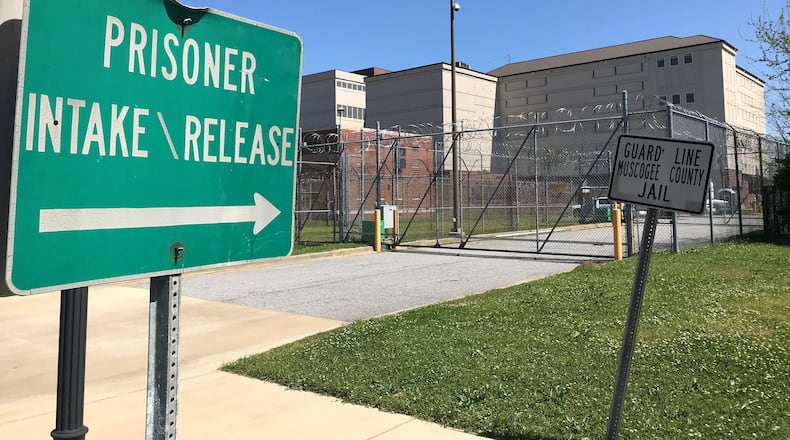In Lori Carroll’s final hours, as her psychotic behavior spiraled out of control, no one at the Muscogee County Jail helped relieve her suffering.
Carroll, 46, had a history of mental illness and had spent multiple stints behind bars for theft, shoplifting and forgery. In her last arrest, officers in Columbus charged her on the morning of Oct. 22, 2013, with disorderly conduct after she harassed drivers at a local school. Police took Carroll to jail after she refused a hospital mental health evaluation.
Over the course of the next two days, Carroll’s condition worsened in the isolation of cell HD-13. She screamed repeatedly and pounded her fist on the cell door. She spoke to imagined people and thought a man was trying to rape her. She struck her head against a wall and a metal bunk, investigative records show.
On the morning of Oct. 24, less than nine hours after a jail doctor placed Carroll on suicide watch, a guard discovered her cold and stiff on the cell floor. Her mouth and eyes were open. Cuts and bruises covered her body. A state medical examiner noted a serious head injury, broken ribs and a collapsed lung that killed her.
"It was like something out of a horror movie," said Justin Blake Toland, Carroll's adult son. "She didn't deserve that. No one does."
Gaps in the criminal justice and mental health systems have turned local jails into warehouses for the mentally ill, often with fatal consequences.
The Atlanta Journal-Constitution, Channel 2 Action News and the Georgia News Lab conducted one of the most comprehensive reviews of jail deaths ever undertaken in Georgia, reviewing the deaths of more than 500 inmates and detainees in the state’s local jails in the past decade. The investigation found:
- One in six deaths attributable to something other than natural causes involved inmates who exhibited signs of mental illness. The deaths were often preventable. Jail staff routinely didn't recognize threats and warning signs until it was too late, ignored or expressed indifference to an inmate's crisis or failed to keep troubled inmates under close observation.
- Thirty of the 168 jail suicides examined by reporters involved inmates where signs of mental illness were noted in public records or press accounts. But the number of these deaths linked to mental health is likely significantly higher. Studies estimate 90 percent of people who commit suicide suffered mental illness.
- The 16 homicides accounted for just a fraction of all jail deaths. But nearly half of those involved inmates who exhibited signs of mental illness.
- No single state or local agency in Georgia tracks how many people die in jails each year or the details of the cases, and federal statistics routinely undercount Georgia's jail deaths. There's little analysis to inform policy discussions and promote training that could prevent jail deaths.
Protecting and treating the mentally ill behind bars is something jailers have struggled with for decades. The federal Justice Department has estimated that nearly two-thirds of all local jail inmates have mental health problems. The prevalence of inmates with a mental illness in Georgia jails seems to have increased over the past decade as the state closed psychiatric hospitals, said Terry Norris, executive director of the Georgia Sheriffs’ Association.
Norris said responsibility now falls to community treatment programs — and the state’s 143 county jails.
“Unfortunately, our county jails have become the primary providers of mental health services for many of our state’s most vulnerable citizens,” he said.
Sheriffs do the best they can with finite local resources to manage this troubled population, he said.
In Carroll’s case, despite her serious injuries, repeated screams and bloodied face, jail guards and medical staff never sent her to a hospital for treatment. The jail’s protective restraint chair, designed to stop inmates from harming themselves, sat unused. Guards and medical staff couldn’t agree on who should make the call to restrain her. They also failed to use less restrictive methods to protect Carroll from self-harm.
Toland and his half-brother sued the county government, jailers and its medical providers alleging willful indifference and a flawed policy that failed to protect the mentally ill. A federal judge dismissed the case against the government and its employees, but last December Carroll’s sons settled with the medical providers.
"It was one of the worst cases in terms of neglect I've ever seen," said Craig Jones, the family's attorney, who has litigated dozens of jail death cases. "She literally beat herself to death right in front of them."
A suicide on cell block C-1
Jade Tramel didn’t hide his intention to leave the Newton County Jail on his terms.
Authorities arrested the 18-year-old Dec. 3, 2013, for marijuana possession, driving on a suspended license and burglary. Shortly after his arrest, Tramel’s mother, Melanie, said she called jail officers to warn them her son was suicidal.
Just weeks into his confinement, a jail staff member found Tramel eating a bar of soap. Officials placed him on suicide watch. Tramel told Sheriff Ezell Brown and others he was depressed and wanted to end his life, according to allegations in a federal lawsuit.
A few weeks later, after he moved off suicide watch, Tramel tied a bed sheet to his cell bunk and tried to hang himself. When guards found him unconscious, the sheet around his neck, authorities rushed Tramel to a nearby hospital. Doctors revived him, treated him and sent him back to jail with instructions to prescribe anti-depressants and place him on suicide watch.
A month later, after Tramel received mental health treatment, a jail doctor cleared him to leave suicide watch a second time and return to a regular cell.
On the evening of March 19, jail managers assigned a jail recruit to supervise the overnight shift on housing block C-1.
The recruit was just weeks into his training with the sheriff’s office and hadn’t yet earned his state certification. No one informed him about Tramel’s troubled history or the previous suicide attempts, a lawsuit alleges.
Tramel seemed fine when the recruit spoke to him before the 11 p.m. lockdown, investigative records show, and nothing seemed amiss during the recruit’s initial hourly bunk checks.
Around 1:15 a.m., the recruit made his second round of checks. When he peered through the narrow window in Tramel’s jail cell, he saw Tramel alone, hanging from a bed sheet tied to the top bunk. By the time guards cut Tramel down, it was too late. Tramel was again taken to the hospital, but this time he couldn’t be revived.
An internal investigation into his death by the Newton County Sheriff’s Department found no policy violations, but investigators noted that recruits who have not received jail certification or completed field training should not be left to supervise an entire housing unit.
‘He was screaming for his life’
Estimates of mental illness among jail inmates vary across the country, from 20 percent up to 60 percent of inmates.
The issue has received renewed focus as the number of jail suicides has hit record numbers across the country in recent years. In 2015, the suicide of Sandra Bland in a Texas jail drew protests, forced discussion about jail suicides and led to reform.
Currently, no one tracks how many Georgia jail inmates have a mental illness. The sheriff’s association is trying to develop a program to count them, document jail deaths and collect other data that can inform the state’s sheriffs tasked with operating county jails.
Five jails from large counties accounted for nearly a third of all deaths identified in the news investigation.
Fulton topped the list with 55 inmate deaths. DeKalb was second with 34 deaths, including the 2015 case of inmate Donte Wyatt, who authorities allege killed his cellmate and ripped out his eyes.
Wyatt, who had been in jail on murder and rape charges, was on mental health lockdown just days before jailers placed him in a cell with Jah’Corey Tyson. Wyatt strangled Tyson in the middle of the night and stabbed him with a sharpened toothbrush, according to court records.
After killing Tyson, Wyatt ate one of his eyeballs and wore the other around as a necklace until he was convinced to give it up, according to a federal lawsuit. The suit alleges jail guards failed to heed warnings about Wyatt’s deteriorating mental state leading up to the attack. Once he went after his cellmate in his sleep, guards ignored Tyson’s pleas for help, the lawsuit alleges.
The other jails in the top five for inmate deaths, include Chatham County Jail in Savannah (26), Cobb (22) and Gwinnett (19), according to the news analysis.
A couple years ago, the Floyd County Jail in Rome faced what Sheriff Tim Burkhalter viewed as a crisis.
One inmate had committed suicide during his first 12 years in office. When two inmates killed themselves in 2016, it caused Burkhalter to re-examine how his jail was managing at-risk inmates.
Burkhalter hired a suicide prevention expert to help revamp training, change the detainee intake process and refocus efforts to monitor inmates deemed suicidal. The changes have made a difference. The jail staff prevented 21 suicide attempts last year and agency leaders said the staff is more confident to manage inmates on the brink.
“Mental health is a real issue in our jails,” said Sgt. Carrie Edge, who helps teach the agency’s suicide prevention class. “Our training has helped to change attitudes and increase awareness about suicide risk, and made our staff more prepared.”
An arrest spirals downward
After decades of serious mental health and physical conditions, medication offered a lifeline for Wickie Bryant.
Growing up in Atlanta, she dreamed of becoming a psychiatrist. But mental illness in her early 20s dashed that hope. A series of jobs and a winding journey through Georgia’s mental health system followed. Medications helped manage her schizophrenia, bipolar disorder, depression, hypertension and diabetes.
Still, with all her troubles, Bryant remained close to a supportive family.
“She was just a ray of sunshine,” said her older sister Mildred Sims, who raised Bryant after their mother died at age 45.
In 2015, Bryant went missing from her group home in Atlanta.
“We just really nearly went crazy because we didn’t know where she was,” Sims said.
Officers arrested Bryant on a disorderly conduct charge that September after Sims reported her missing. When she was booked into the Atlanta City Detention Center, a medical screening identified her mental and physical ailments, but that did little to stall a rapid decline.
Bryant refused testing to monitor her blood-glucose level and wouldn’t take insulin. About a week after her arrest, she requested the jail medical staff obtain her medical history and prescribe medication to help manage her schizophrenia and depression. According to the lawsuit, none of that happened.
Over the next week, Bryant continued to neglect her medication, even though Sims said she told jail staff about it and they assured her they would monitor it.
She spent a few weeks in the special needs section of the jail, but on Oct. 5, she was transferred to maximum security. Cell 202, where she was held in isolation, was unlit. In that environment, her mental and physical health deteriorated. At one point, a jail officer found Bryant lying naked in bed and mumbling incoherent thoughts, the lawsuit alleges. Another time a jailer found feces in front of her cell.
On Oct. 13, an inmate noticed Bryant hadn’t touched her food. She laid in bed and said nothing. When the inmate tried to relay her concerns to guards, they ignored her, the lawsuit alleges.
Guards checked on Bryant several times that afternoon. The last time, hours later, they saw dried vomit covering her face. The reek of urine filled the room.
“I got this call that she was deceased,” Sims recalled.
Her sister had suffered a diabetic coma. The federal lawsuit alleges willful indifference on the part of the city's jail supervisors and staff. It criticizes inadequate policies to manage and maintain the health of mentally ill detainees.
Sims thought her sister was safe in jail because it had medical staff.
“I felt relieved she was no longer on the streets,” she said.
Sims is left with memories and daily prayers for her sister.
"From my heart, I know she's in a safe place now," she said. "But it still doesn't stop the pain."
The Atlanta Journal-Constitution, Channel 2 Action News and the Georgia News Lab collaborated on this story. The News Lab, based at Kennesaw State University, is an investigative reporting project of Georgia's leading college journalism programs, in partnership with the AJC and Channel 2. The partners compiled 10 years of jail deaths from state and county medical examiner records, death certificates, autopsies and case files from the GBI and other agencies. The AJC's Jennifer Peebles built the database with technical expertise from Jeff Ernsthausen. Reporters flagged cases for mental illness after reviewing case records. Reporters interviewed jail officials, investigators, attorneys, mental health and correctional institution experts, and family members of deceased inmates. AJC investigative reporter Brad Schrade assisted with reporting and wrote the story. News Lab reporters were: Ryan Basden (Kennesaw State University), Avery Braxton (Mercer University), Jenna Eason (Mercer), Hannah Greco (Georgia State University), Nate Harris (University of Georgia), Victoria Knight (UGA, graduate student), Ayron Lewallen (Morehouse College), Christina Maxouris (GSU), Michael Mays (GSU), Chad Rhym (Morehouse), Naomi Thomas (UGA, graduate student), Dominique Times (GSU), Harrison Young (UGA).
Keep Reading
The Latest
Featured













